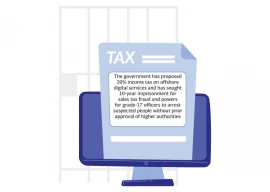
Brewing together decades of history and culture within its myriads of flavours, tea is of paramount importance in the lives of Pakistanis. With the mushrooming of chai dhabas i.e. tea stalls across urban spaces, there is a clear indication that Pakistanis are not giving up on this love affair, with the tea market expected to grow at a rate of 1.16% per annum for the next five years.
From an economic perspective, the consumption of tea does present a dilemma. For a country engulfed in economic turmoil ranging from foreign reserves limitation to managing the balance of trade, tea is a headache. Why? Pakistan and its 220 million citizens are credited for being the largest tea importers. Back in 2020, figures from the Observatory of Economic Complexity revealed the country imported tea worth $640 million. Moreover, according to a recent report, the value of tea imported in August 2024 stood at a staggering Rs16.32 billion. Compared to last year, this shows a 1.56% increase as of August 2023 (Rs15.9 billion).
No wonder that not so long ago, Federal Minister Ahsan Iqbal urged the nation to reduce tea consumption by 2 to 3 cups to help the economy. While his statement back then was ridiculed by the masses, the bottom line remains that Pakistan imports the tea that it ends up consuming. With a country aiming to tackle factors contributing towards economic negatives, the ideal situation would be to stop the consumption of a commodity that has such a large price.
On the contrary, jumping to a conclusion by assessing a figure would be unjust. While it is true that the country has a significant burden of tea imports, the fact remains that this import leads to economic activity and prosperity. How so? With multiple brands dedicated to selling tea, employment opportunities and money circulation become a thing with buyers and sellers connecting. Local economies benefit from chai dhabas in the areas, as they generate economic activity and prompt enterprise.
Leaving aside the economic positives, the emergence of high-end chai dhabas are slowly becoming the symbol of resistance. Urban spaces are now accustomed to the social hubs that serve chai in major cities such as Lahore, Karachi and Islamabad, replacing the Quetta hotels, reflecting the changing chai culture. With the earlier spaces mostly dominated by men, the new and fancier chai spots are helping women claim their place in urban spaces with each cup of chai. With better seating arrangements and a paradigm shift in the perspective of tea serving, families are attracted to come out for a nice cup of tea. The trendy decor, fancy yet intriguing options on the menu, and the new chai spots have transformed the concept of traditional middle-class outdoor tea stands into something the bourgeois also look towards.
With all these outcomes, the question comes back to square one. However, rather than outright disapproval or approval of tea, the idea of sustainability should be floated. While Pakistan is easily one of the biggest importers, it surprisingly ranks 35th among the world's tea exporters. In 2022, Pakistan earned $21.5 million in tea exports as the country produces approximately 15,000 metric tons of chai annually.
Whether you drink 'mixed' or 'separate', spell it as 'chai' or 'chaaye', Pakistanis treat tea as a necessity rather than a want. This may explain that even with price hikes, demand does not fall as expected, with tea considered price inelastic. But it is not the leaf and boiled water that makes it magical. It's the social gathering - an opportunity to sit with a beloved or even a stranger and engage in a candid conversation, strengthening bonds. The wish that the country halts the use of tea is far-fetched. Still, with sustainable practices and exploration of import-substitution practices, Pakistan can benefit from reduced strain on import bills and reap the benefits tea and cafes present to the local economies.














1737452260-0/Gaddafi-stadium-(2)1737452260-0-270x192.webp)





COMMENTS
Comments are moderated and generally will be posted if they are on-topic and not abusive.
For more information, please see our Comments FAQ